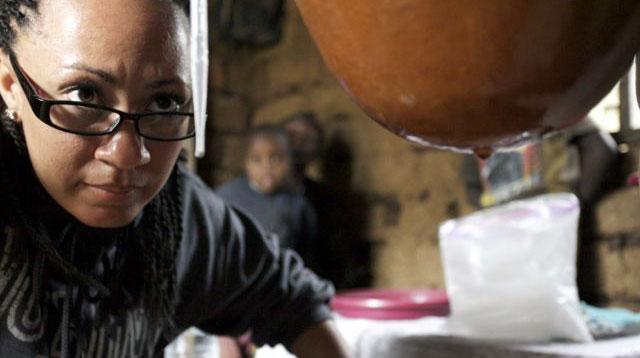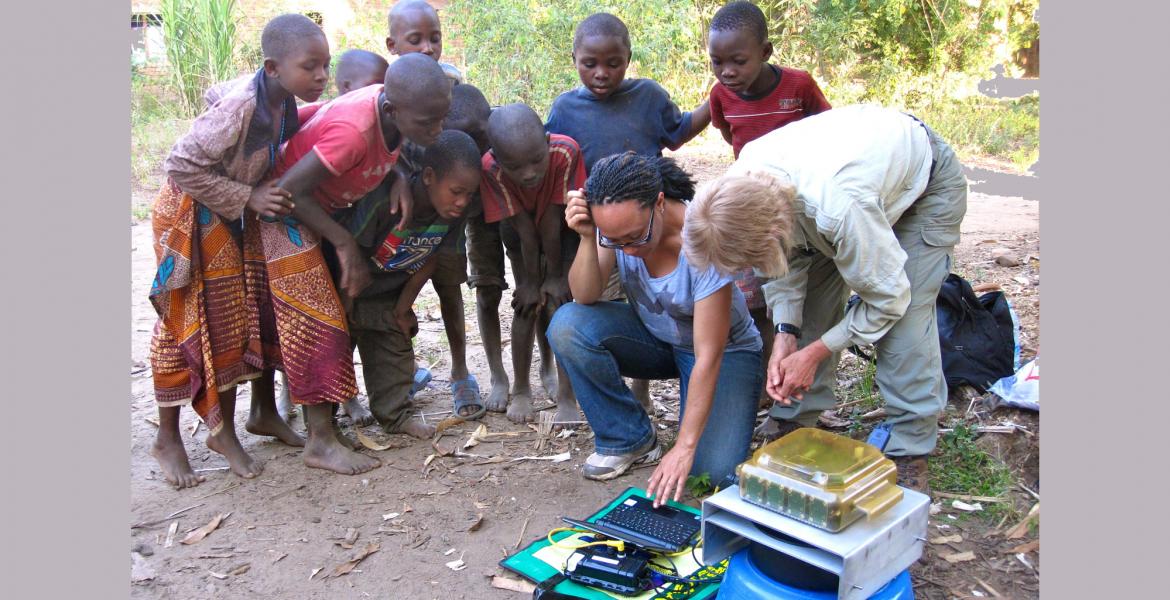UA Engineer Goes Back Country Biking in Tanzania to Test Local Water Sources
Fifty miles of dust and ruts separate Ifakara from the nearest paved road -- a distance more comfortably crossed by foot than rattling four-wheel-drive, if it weren't for the malarial mosquitoes. Tracks alongside this "road" bring a train to town twice weekly.
There are few sanitary facilities and no municipal water system in this remote Tanzanian town. Ifakara and the surrounding region get water from open wells, the Kilombero River, and more than 100 deeper wells.
Most of the open wells are hand-dug, shallow, and prone to contamination, while the drilled wells, which are capped and topped by hand pumps, can provide pathogen-free water. Despite their humble appearance, these hand pumps -- and the wells below them -- can be critical to public health.
Water-borne diseases, such as diarrhea and cholera, contribute to a life expectancy of 53 for men and 58 for women in this East African country and to the deaths of more than one in ten children before age five.
Clean water is vital to improving public health, but the deeper, capped wells can be part of the solution only if they remain clean and haven't developed bacterial contamination in their pipes, or aren't pumping from underground sources that have become contaminated.
MSABI, a nonprofit, nongovernmental organization that drilled many of the wells, wants to determine which ones are polluted so they can be fixed or shut down. To do this, MSABI teamed with a group from Michigan Technological University to sample the wells. MTU researchers, in turn, asked a University of Arizona professor and PhD student to apply their special expertise and high-tech instrumentation to the problem.

Wheels in Motion
That's how UA Engineering professor and BIO5 member Linda Powers and PhD student Aminata Kilungo ended up bicycling to various Ifakara water sources in July. They were out cycling and testing for as much as 15 hours a day, with their instrument and a laptop computer tucked in backpacks. On site, they set the instrument above a plastic tub of water, hooked up the computer, and focused light (ultraviolet, amber and red) on the water samples, looking for the telltale fluorescence emitted by bacteria.
No need to laboriously label samples or to transport them to the lab for incubation. The UA instrument provides results on-site in real time. Other instruments use similar methods to expose microbes but "the problem is they don't have very good sensitivity and they're not portable," said Powers, of the UA department of electrical and computer engineering.
Kilungo, a PhD student in the UA soil, water and environmental science department, is developing an instrument based on these principles that can continuously monitor water flowing through a pipe. It can detect as few as five microbes per liter. But it's still being developed and is too unwieldy for fieldwork, particularly by bicycle.
The instrument Kilungo and Powers took to Ifakara was adapted from one originally designed by Powers to find microbes on surfaces, such as those in hospital operating rooms. "We didn't have the time or money to build a new instrument, so we revamped this one," Powers said. In its modified state, it can spot concentrations of 1,000 to 10,000 bacteria per milliliter.
Infection Risk
This was more than sensitive enough, said Powers, who feared some heavily contaminated sources might actually overwhelm the instrument. And some of the open wells and the river did show high levels of contamination. "There were tons of kids swimming in that swollen river that was just crawling with bacteria," Powers said.
Nate Arnold, a master's student at MTU and the son of UA professor Robert Arnold, in the chemical and environmental engineering department, contacted Powers and Kilungo about the Tanzanian project after seeing a description of their work in a UA publication.
"Nate pieced everything together for this project and had it ready to roll once Aminata and the others got to Tanzania," said Kurt Paterson, an MTU associate professor of civil and environmental engineering and director of the D80 Center, an umbrella organization for MTU's many international programs that focus on service and research in developing countries.
"We coupled the UA instrument with two more traditional testing methods," Paterson noted. The other methods required incubating samples at the Ifakara Health Institute, a Tanzanian organization renowned for its malaria research. MTU master's student Kelli Whelan led this part of the project, which served as a check on the data being collected by Powers and Kilungo.
Whelan and Arnold are both in the MTU Peace Corps Master's International Program in Environmental Engineering. Students in this program start their course work at MTU and then serve two years in the Peace Corps before returning to MTU to complete their studies and write a thesis related to their Peace Corps projects.
Kilungo, Arnold and Whelan also tested passive ceramic water filters made by SWaN (Safe Water Now), which is located in Arusha, Tanzania. The inexpensive filters are designed for home use.
"We were measuring both the flow rate and the bacterial removal as water passed through the filters," Arnold said. "In order for a filter to be effective, it must provide clean water relatively quickly."
Right Partners
"I have to give MSABI a good deal of credit for their interest in testing the wells and comparing them to unimproved wells," Paterson said. "A lot of well-intentioned people and organizations in the development area are not as concerned about monitoring the performance of their efforts, but MSABI was interested in that. We're always looking for the right partners to work with, and they were really, really good."
MSABI provided a cultural liaison, Novatus Mwangeta, to accompany the group. He spoke the local dialect, knew where all the wells were located, and, at the same time, was learning some of the testing methodologies from the MTU/UA group. "It was good to have a guide because we were out in the middle of nowhere for miles," Powers said.
Powers stayed in Tanzania for two weeks to be sure the equipment was operating properly, and Kilungo worked with the MTU group for a month, while the MTU program spanned three months.
"Our students are working with Tanzanians, usually in small, rural communities that have very pressing needs, but extreme constraints," Paterson said. "The cool thing is to see the students contributing some really important value to people who don't get a lot of attention."


